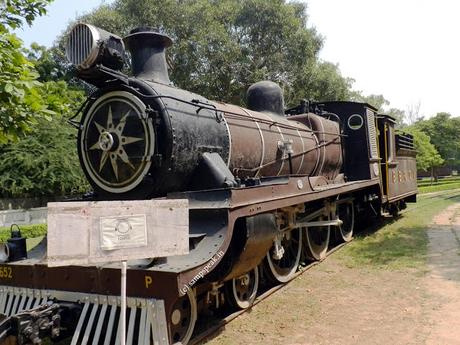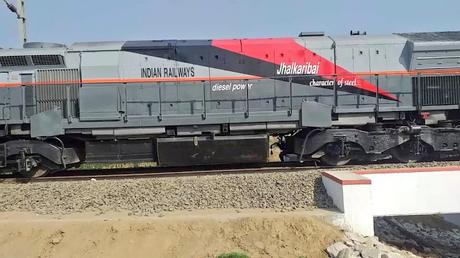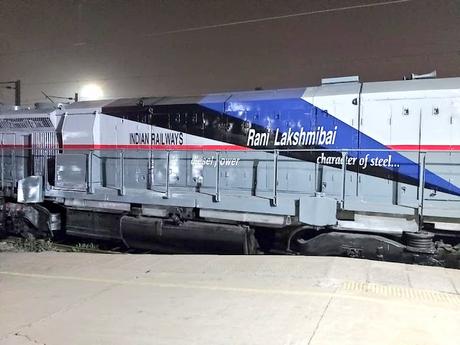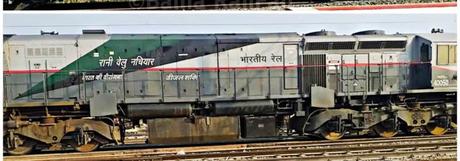I have travelled so many times by train – pre 1990s booking ticket was an ordeal – when Computerised Reservation complex came up at Allikulam complex near Central, it was a great boon. It was a conceptual barrier broken - that one can stand in any Queue and book ticket for any train from anywhere in India to anywhere else in India. Then came the revolution of booking from home through Internet and the need for not carrying the printed ticket ! .. .. the first attraction in a train of course was its Engine.

Now it is all about Electric and Diesel ones – no longer the steam, charcoal fueled ones. The Indian Railways primarily operates fleet of electric and diesel locomotives, along with several compressed natural gas (CNG) locomotives. Steam locomotives are operated on a few World Heritage sites and also run occasionally as heritage trains. A locomotive, also known as a loco is simply the ‘engine’.
Much earlier to the Train’s first journey from Boribunder to Thane, country's first steam locomotive ran on the Red Hill Railway (built by Arthur Cotton to transport granite for road-building) from Red Hills to the Chintadripet bridge in Madras in 1837.
A locomotive or engine is a rail transport vehicle that provides the motive power for a train. Traditionally, locomotives pulled trains from the front. However, push-pull operation too became common, where the train may have a locomotive (or locomotives) at the front, at the rear, or at each end. Not many would know that in Indian Railways Locomotives are easily identifiable by the classification codes. This code is of the form '[gauge][power][load][series][subtype][suffix]'. In this the first item, '[gauge]', is a single letter identifying the gauge the loco runs on:W = Broad Gauge; Y = Meter Gauge; Z = Narrow Gauge (2' 6") & N = Narrow Gauge (2'). The second item, '[power]', is one or two letters identifying the power source.
Another attractive feature of the locomotive is of course its headlight. Usually this is a single centrally mounted light near roof level at each end, although some locos have it at mid-level. Some of the newer locos feature twin-beam headlight fixtures. The headlights can be dimmed if needed. All recent locomotives also have a flasher lamp for use in emergencies or special circumstances. This is usually amber or yellow, and mounted close to the headlight near roof level, or on the edge of the roof.
Reading Railway history in IRFCA – in the 19th century and early this century, named locomotives were quite common. Many were named after administrators ("Lord Clive") or nobility ("Prince Albert"), or mythical figures ("Hercules"). Indian names were also included ("Tungabhadra", "Shakuntala"), and some whimsical ones as well ("Moth", "Ant", "Jimpeebuttee", "Perleewerlee"). Thomason was the first locomotive ever to be used in India (1851) & the second one had the name Falkland. The most famous ones were : ‘Sahib, Sultan, Sindh’ – the three that hauled the first passenger train in India (1853). Another famous one is ‘Fairy Queen’ a steam locomotive of 1855, working still.
Stop – all that is of the past – the history, the new history is different ! To mark International Women’s Day 2021, the Northern Railway dedicated its WDP4B and WDP4D class locomotives to woman warriors of the country. The engines were named after Uday Devi along with Rani Ahilyabai, Rani Avantibai, Rani Laxmibai, Rani Velu Nachiyar, Rani Chennamma and Jhalkari Bai.
Chief Public Relations Officer of Northern Railway, said that the Northern Railway commemorates the performance of Tughlakabad Shed for over five decades by remembering the brave women from our history, who, have led their armies into battle for Independence. This was tweeted by Minister Mr Piyush Goyal also. He also said that women's day was chosen for the honor as this day celebrates the social, economic, cultural and political achievements of women. This day also calls for action to expedite the grant of equal rights to women. He said that the railways have never lagged behind in giving respect to women.
It is a matter of great pride for the Nation and women that engines have been named as Rani Ahilyabai of Indore, while a train was named as Rani Laxmibai. Along with this, locomotives were also been named after the popular South Indian queen Chinnamma and Queen Velu Nachiyar. This is the first time Indian Railways have shown respect and recognition for women who sacrificed their lives in the country's freedom movement. Railway Minister Piyush Goyal tweeted "Salute to the indomitable woman power, Tughlakabad diesel shed of Indian Railways paid tribute to brave women freedom fighters who displayed strong character like iron."




Interesting ! though posted late here.
With regards – S. Sampathkumar29th May 2021.

